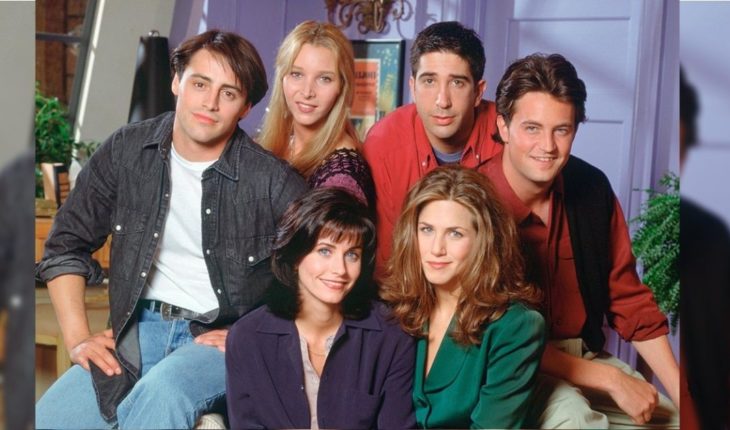You go to bed and turn on the TV but you don’t know what you can see, put on a chapter of Friends. You’re done performing a partial and want to clear your head, put on a chapter of Friends. Because “looking again” never stopped you, put on a chapter of Friends. And so on. Today marks the 25th birthday of the arrival of “Friends” on television, the series created by David Crane and Marta Kauffman and consisting of a world-class cast: Jennifer Aniston, Courteney Cox, Lisa Kudrow, Matt LeBlanc, Matthew Perry and David Schwimmer.With the passage of the years , and thanks to your arrival on different platforms like Netflix, the experiences of the group of friends spread throughout all corners of the world, whether the famous ‘How you doin’? Joey or Ross’ “Unagi.” Undoubtedly, it marked a before and after in the history of the series, and became a global cultural phenomenon. Today, however, following the generational change and the change of era, many millennials and centennials put a brake on success and even encouraged theself to question its content. What’s it all about? Can you identify current youth and new audiences? To understand more details, Filo.News spoke with Federico Carestia, journalist editor at Cinéfilos and creator of the Youtube channel “Look at who I met”, and with Fabiana Solano, sociologist, journalist specializing in youth pop culture and producer of Ultrabit. Why is “Friends” so successful?
25 years of “Friends”
According to the newspaper El Confidencial, every day, around the world, an average of 16 million chapters of the series are consumed. In 2015 she was voted the best series of all time by The Hollywood Reporter. In 2018 Variety indicated that the series is the most marathon in history, meaning that four chapters are seen in a span of 25 hours. As reported by The Wall Street Journal, based on Nielsen data, Friends is the second most-watched series on the US platform; between 2017 and 2018 Netflix users watched 31.8 billion minutes of the series. The data speaks for itself, to what is the reason for this success? Mainly to identify the audience with each of the characters in the series. This is considered by the interviewees, who indicate that Chandler, Joey, Rachel, Monica, Ross and Phoebe have different characteristic features and profiles that seek to identify different audiences. But they also connect with the experiences and experiences that one goes through in real life: “It reflects a way to live or try to see what it means to live, what we want to do with our lives. It is very basic the premise of Friends: friendship, love, work, knowing that not everything is solved, how to deal with the most basic problems such as not having laburo and having to pay the rent, you will be a dad, that’s why it is still so important”, says Carestia.
He then adds: “It’s a cultural phenomenon because despite being a Yankee series, set in New York, in a group of middle-high-house friends, you end up connecting the same, because they play universal topics (…) He managed to capture a moment of people who were 20, 30 years old and projected it into everyday stories.” This is understood by Solano, who agrees: “The key by which Friends is still in force today is that it is a model that generates very easy identification (…) The problems it works are real, which have to do with a moment of life, the passage from childhood to adulthood, the entry into the labor market, and the neurosis it causes, the contradictions, the changes of perspective. The characters grow along with the audience, those who saw it we transfer our moments of life with what happens to the series, shows the human side, vulnerable. That’s what makes it a success that transcends time. It is a standard model that crosses many cultures and lives in many countries.”
“For my Friends it’s a fantastic series, it represented a period model, a photograph of the youth of that time,” says Solano.
“It remains current because it is a timeless model, it is not linked to a historical development of the United States of that time, beyond certain symbolic gestures of the time, it is a script more linked to the moment of people’s lives and not the historical moment of a country. Anyone who grew up with that model can identify some time in their life with some Scene from Friends. That necessarily generates empathy and that makes it a successful model,” he adds. Today, does the series identify youth?
25 years of “Friends”
No doubt we all know someone who has seen “Friends,” or someone who considers them their favorite series. However, we do not live with the same intensity in the new generations. Over time the series began to be questioned by many young people in the world, mainly for two reasons: the lack of identification in the face of generational change and reflections on the “machista” content of history.” Friends no longer defines society, of American youth, if there may be any sector that still feels identified, but It seems to me that no longer, that’s why the series is still much loved by people who grew up with it or who are still watching it and who are 30 or 35 today, but not with the under 20s, sub25s,” says the reporter. So, as the British newspaper The Independent noted, the series does not get new audiences in the UK because they are impacted by how it addresses different issues related to sexual identity and gender. In addition, on social media many called the program “sexist”, “machista” or “homophobic”. Is it really like that? “I don’t think he’s sexist or sexist. Speech and questioning of machismo is very present from the script; what was happening at the time, common sense was not so embedded in the question of feminism. It should be remembered that this series was filmed in the 90s, at that time everything that is discussed now was not on the agenda,” says Solano.
Undoubtedly, the rise of the feminist movement allowed the development of a more critical view with audiovisual products. This was the case in Argentina, with repudiation of different old series such as “Poné a Francella” and where the movement of #NiUnaMenos was made to listen in every march and every claim. But also, globally and particularly in the United States, #MeToo gained strength in Hollywood to fight against machismo. All that clear, since 2019. Is it fair to judge a series from another era under this social and political gaze?” It is very difficult to analyze a series by taking it out of the context from which it came out,” carestia says, and continues, “is macho? yes, but it has to do with character building, it’s not that the show’s message is to be sexist, it has to do with a time where ties and family were the most important thing. Today millennials have another, much more fluid notion, it’s not something so black or white, it’s something greyer,” carestia explains.
“It’s hard to judge it with the 2019 magnifying glass of what feminism and machismo is,” carestia says.
Solano emphasized that, in the series, different manifestations of the writers against these prejudices occur, either about the traditional scheme of the family and reference to a marriage between lesbians – the case of Ross, Carol and Susan – reference to characters trans – Ross’s mother – that there is gender equity in terms of the number of members in the team – three women and three boys – addresses the maternity debate – Phoebe’s case – the desired motherhood or not – when Rachel considers whether she should have her child – and who and women hold independent positions. Against this backside, can the series be considered sexist? “Friends put a lot of topics that up to that point in the mainstream series were not seen. To think of it as sexist seems to me to be a waste, it is to look at it from a current era that does not correspond,” he says. For many, this landscape contributes to a larger problem with the series: the lack of identification that much of young people have with their history, with their problems, with the characters. What’s this all about? “It seems to me that it was cut. It is very rare to see a kid of 25 or a little less that connects to the series in the same way that we connect those who saw it at the time, or in the 90′. I don’t think there’s a generation that lost that connection, not that they don’t understand it, but they don’t share the code. I’m not saying they’re all, there’s 20-year-old kids who see it and they love it, they’re not the vast majority,” says the reporter.
“Millennials don’t connect with the show, and I’m millennials,” Carestia says.
Solano explains: “The series represents American youth in the 90’s, which is when it was filmed, today and especially after the 2008 crisis, American youth do not live that way, has far more problems than it had with Friends . Today unemployment has increased, there is much more violence, it is not as easy to rent an apartment in the middle of Manhattan as that time, technology has made it different. It does not represent youth on any current side.” Likewise, relationships in Friends are built without any social networks in the 90s, it is a series away from social networks and the tech boom, without WhatsApp messages or without any post on Instagram. Is it a point for or against the series?” They have no social media and it’s a bit the wealth of the series,” says Solano, adds, “links are generated differently. Many chapters of the series have to do with this, with the mystery of the bonds, the waiting for the call, of not knowing how to present theself. Today it continues to transcend because it generates empathy and identification, we all live moments and contradictions and that has nothing to do necessarily with technology.” “Centennials have grown up in a completely different world, have already lived and been raised with other imaginaries, with another common sense, with other ways of seeing the bonds, other ways of looking at cultural consumption and already such series do not represent it, since in a series there are no computers or cell phones probably does not represent them, or do not have the speed or dynamics in which they are consumed on Youtube, with other series that suppress them ntan more,” he says. Looking ahead: what’s going to happen to the series?
25 years of “Friends”
At the moment, the series remains one of the most viewed. Even when Netflix announced that it was going to be taken out of its catalog, it spawned a wide-ranging move on Twitter to ask that it be left for a while longer, to extend its contract. Everyone wanted to see her one more time. Still, the lack of identification today is present in them and, mainly, in the next generations: “I don’t think the centennials are represented in Friends. They do not understand sexuality in the same way that we understand it, they have another kind of vision about desire, about the freedom of the other, kinds of bonds, I think That Friends has in that sense a roof, which has to do with the generation and with a kind of bond that it represents that the centennials don’t fit anymore,” says Solano.
“I don’t think the centennials are represented in Friends,” she says.
Faced with this scenario, what will happen in the future with the series? “It seems to me that if it’s going to remain a success, because it’s a picture of an era, but I don’t think it’s going to generate the same from now on as it generated with us,” Says Solano. For his part, Carestia reflects: “It is a series that will continue to be aimed at a certain age group; guys today watch series are used to watching series in a different way, much shorter season. So, for me, the passion for the series may be extinguished.” Anyway, “Friends” will always be there for every person who needs it: “I grew up watching Friends, I was younger, to this day it is the series that has brought the most happiness, it generates me tranquility, joy, transmits to me that the complex of life can also be simple, and that the nice things about life are, is a message that gives a little relief to those of us who grew up within a society that requires us to be much more than we can, with parents who put expectationon on us, Friends welcomes many things that happen to us society,” says Solano.And you, what do you think? Do you feel identified or identified with Friends?In this note:





